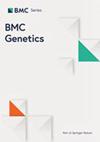Investigating the impact of non-additive genetic effects in the estimation of variance components and genomic predictions for heat tolerance and performance traits in crossbred and purebred pig populations
IF 2.9
Q2 Biochemistry, Genetics and Molecular Biology
引用次数: 0
Abstract
Non-additive genetic effects are often ignored in livestock genetic evaluations. However, fitting them in the models could improve the accuracy of genomic breeding values. Furthermore, non-additive genetic effects contribute to heterosis, which could be optimized through mating designs. Traits related to fitness and adaptation, such as heat tolerance, tend to be more influenced by non-additive genetic effects. In this context, the primary objectives of this study were to estimate variance components and assess the predictive performance of genomic prediction of breeding values based on alternative models and two independent datasets, including performance records from a purebred pig population and heat tolerance indicators recorded in crossbred lactating sows. Including non-additive genetic effects when modelling performance traits in purebred pigs had no effect on the residual variance estimates for most of the traits, but lower additive genetic variances were observed, especially when additive-by-additive epistasis was included in the models. Furthermore, including non-additive genetic effects did not improve the prediction accuracy of genomic breeding values, but there was animal re-ranking across the models. For the heat tolerance indicators recorded in a crossbred population, most traits had small non-additive genetic variance with large standard error estimates. Nevertheless, panting score and hair density presented substantial additive-by-additive epistatic variance. Panting score had an epistatic variance estimate of 0.1379, which accounted for 82.22% of the total genetic variance. For hair density, the epistatic variance estimates ranged from 0.1745 to 0.1845, which represent 64.95–69.59% of the total genetic variance. Including non-additive genetic effects in the models did not improve the accuracy of genomic breeding values for performance traits in purebred pigs, but there was substantial re-ranking of selection candidates depending on the model fitted. Except for panting score and hair density, low non-additive genetic variance estimates were observed for heat tolerance indicators in crossbred pigs.研究非加性遗传效应在估计杂交猪和纯种猪群体耐热性和性能性状的变异成分和基因组预测中的影响
在家畜遗传评估中,非加性遗传效应往往被忽视。然而,在模型中加入非加性遗传效应可以提高基因组育种值的准确性。此外,非加性遗传效应还有助于异质性,可通过交配设计对其进行优化。与适应性和适应性相关的性状,如耐热性,往往受非加性遗传效应的影响更大。在这种情况下,本研究的主要目的是估算方差成分,并评估基于替代模型和两个独立数据集(包括纯种猪群体的生产性能记录和杂交哺乳母猪的耐热性指标记录)的基因组预测育种值的预测性能。在对纯种猪的表现性状建模时,加入非加性遗传效应对大多数性状的残差估计值没有影响,但观察到的加性遗传变异较低,尤其是在模型中加入逐加外显性时。此外,加入非加性遗传效应并不能提高基因组育种值的预测准确性,但在不同的模型中存在动物重新排序的情况。就杂交种群中记录的耐热性指标而言,大多数性状的非加性遗传方差较小,标准误差估计值较大。然而,喘气得分和毛发密度的外显性差异很大。喘气得分的外显变异估计值为 0.1379,占总遗传变异的 82.22%。毛发密度的外显变异估计值为 0.1745 至 0.1845,占总遗传变异的 64.95%至 69.59%。在模型中加入非加性遗传效应并不能提高纯种猪性能性状基因组育种值的准确性,但根据所拟合的模型,候选猪种的排名会有很大的调整。除了气喘评分和毛发密度外,杂交猪耐热性指标的非加性遗传方差估计值较低。
本文章由计算机程序翻译,如有差异,请以英文原文为准。
求助全文
约1分钟内获得全文
求助全文
来源期刊

BMC Genetics
生物-遗传学
CiteScore
4.30
自引率
0.00%
发文量
77
审稿时长
4-8 weeks
期刊介绍:
BMC Genetics is an open access, peer-reviewed journal that considers articles on all aspects of inheritance and variation in individuals and among populations.
 求助内容:
求助内容: 应助结果提醒方式:
应助结果提醒方式:


